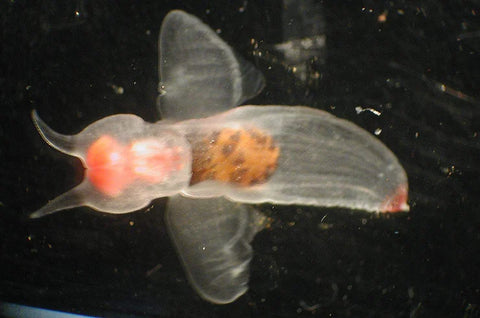9. CLEANER WRASSE

In the underwater world, there are gas stations too. It is not used for refilling energy but for cleaning. They are generally territorial around a coral formation called a "cleaning station." The Cleaner Wrasse will be waiting for other fish to stop by the same spot. They announce their services by swimming up and down in a distinctive movement to attract fish of all sizes to ask for the benefits of the cleaner wrasse by adopting odd positions.
COMMON NAME: Cleaner Wrasse
SCIENTIFIC NAME: Labroides dimidiatus
DIET: external parasites of the damaged or sick tissues of other fish
SIZE: Its maximum size is 11 cm.
10. JUVENILE FLYING FISH

Sometimes we are excited to see Flying fish, but who knows how cute they look when they are juveniles? It can be during a night dive, under the water on the way to the surface. Get the flashlights on the water, and you may see these juvenile flying fish dancing on the water's surface.
COMMON NAME: Flying Fish
SCIENTIFIC NAME: Exocoetidae
DIET: Omnivore, feed on zooplankton
SIZE: Its maximum size is 32 cm.
11. PUFFERFISH

Pufferfish are well-known for inflatability. They are slow and clumsy but poisonous. They can be chilling on the ocean floor, on the sand, without worrying about anything. The pufferfish can change colors as well. Please do not make them blow up on purpose because they can do it only several times in their lives. And every time they do, they have to risk it with their heart rates.
COMMON NAME: Pufferfish
SCIENTIFIC NAME: Tetraodontidae
DIET: Carnivore, primarily invertebrates and algae
SIZE: Up to 90 Cm.
12. Damselfish

There is this kind of fish that do farming by themselves. They are called Damselfish. They are found in shallow water and take care of the seaweeds, their favorite food. They will grab carbon bubbles by mouth and put them on their seaweed farm. They can get angry when people get through their farms. You can notice the color changes from black to yellowish-orange.
COMMON NAME: Damselfish
SCIENTIFIC NAME: Pomacentridae, demoiselle
DIET: Herbivore-based, consume plant and animal foods alike
SIZE: Up to 30 Cm.
13. Coral Crab

The Coral Crabs live among the branches of coral. They are guarding their houses, corals, from predators. And the Corals provide the crabs home and food in return for their protection. They collect mucus, bacteria, and coral flesh and then eat that mixture.
COMMON NAME: Coral Crab (or Trapezia Crab)
SCIENTIFIC NAME: Brachyura
DIET: collect mucus, bacteria, and coral flesh and then eat that mixture SIZE: 1-4 Cm.
14. Sea Angel

Whenever there are seasonal Jellyfish and a lot of plankton, it is not too bad in the sea when you can see these little Sea Angels. These creatures, with their translucent, gelatinous skin, luminous glow, and mysterious looking, almost make them seem unreal. These sea angels live in the depths of our ocean. They are tiny, around 2-5 Cm. They are Micro Photographer's favorite.
COMMON NAME: Sea Angel
SCIENTIFIC NAME: Gymnosomata
DIET: Only sea butterflies
SIZE: 2-5 Cm.
15. Morey Eel

These creatures are the alien that humans can imagine. They have two sets of jaws; the second one hides inside the central mouth farther back in the head with another set of sharpening teeth. Their eyes are small, but they have also developed a good sense of smell—the Moray Eels are fish, not reptiles.
COMMON NAME: Morey Eel
SCIENTIFIC NAME: Muraenidae
DIET: carnivorous predators and feed primarily on smaller fish, octopuses, squid, cuttlefish, and crustaceans
SIZE: 15 -450 Cm.
16. Cobia fish

They are usually found on the table, but around Koh Tao, they might need to be bigger for the table. They can be around 1-2 meters long. Their swimming gestures look exactly like sharks. People are quickly getting scared of them. There are a couple of points to notice on their head and mouth areas to differentiate them from sharks.
COMMON NAME: Cobia Fish
SCIENTIFIC NAME: Rachycentron canadum
DIET: carnivores feed on crustaceans, cephalopods, and small fishes. Their favorite is crab.
SIZE: Up to 200 Cm.

